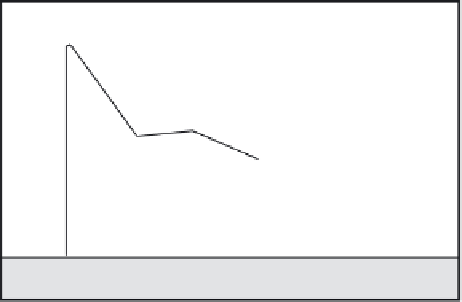Geoscience Reference
In-Depth Information
(a)
0 10 20 30 40 50 60 70 80
Burned drainage area (%)
(b)
10
3
Fig. 3.12
Responses of rivers to forest fires.
(a) Relationship between cross-sectional
stream power and percentage of burned
drainage area. The solid line represents the
regression line and the dashed lines represent
the minimum and maximum cross-sectional
stream power values. Note the important
increase in minimum stream power for more
extensively burned basins. (After Legleiter et al.
2003, fig. 6.) (b) Fire-induced sediment yield
against 'baseflow' yield in the Mount Carmel
area, Israel. The 1992 increase in sediment
yield is due to exceptionally heavy rains.
(After Inbar et al. 1998, fig. 17.)
Measured yield in experimental plots
10
2
10
1
Assumed trend
10
0
10
−
1
Fire-induced 'accelerated' sediment yield
10
−
2
Baseflow sediment yield (control plot)
* 1 2 3 4 5 6 Years
1989/90 1990/91 1991/92 1992/93
can be rapidly aggraded with great thicknesses
of volcanic deposits (ash, pumice, bombs). The
1991 Mount Pinatubo eruption in the Philippines,
for example, resulted in infilling of valleys with
200 m of volcanic debris (Scott et al. 1996). The
most devastating effects on rivers, however, arise
from lahars (Cronin et al. 1997; Hayes et al.
2002). Lahars are hyperconcentrated to concen-
trated volcanic debris flows, which move at high
speed downslope and can reach considerable
distances downstream. They are caused by pyro-
clastic (hot) flows combined with snow melt
(Fig. 3.13), or heavy syn- or post-eruptive rain-
fall (Neall 1976). Lahar formation is favoured
by high slope gradients, removal of vegetation
due to eruptive activity, an abundance of uncon-
solidated volcanic ejecta and, in many cases,
pre-existing channel and channel bed morpho-
logy (Hayes et al. 2002). Channel and floodplain
sediments in volcanically affected rivers are incised
and reworked relatively soon (often within a
matter of years) after deposition (e.g. Janda
et al. 1996). This can result in the deposition
of alluvial fans and in destruction of property
where population centres lie downstream. For
information on volcanically triggered sedimen-
tation events see Chapter 2.
3.4
PROCESSES AND IMPACTS OF ANTHROPOGENIC
ACTIVITIES
3.4.1 Anthropogenic impacts on rates and styles
of sedimentation
Human exploitation of natural resources from
prehistoric times through to the present day has
had a very significant impact on the hydrology,




















